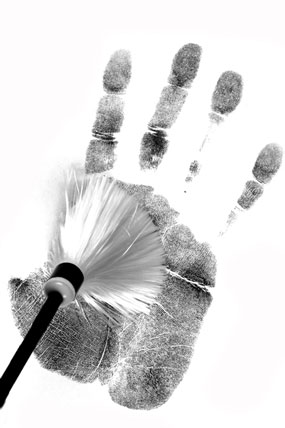Criminalistics is the interpretation of physical evidence. This information is used to help reconstruct a crime scene and place people at the scene.
Criminalistics include serology, DNA typing, trace evidence, firearms and toolmarks, impression evidence, and drug identification. It takes all the physical evidence found from the scene and analyzes them. They are relied on to identify gun models, bullets, car models, and much more. (Citation 12)
Certain tools are used after evidence is collected.
 Dusting for fingerprints. (Image 1) | One of the biggest things they deal with is fingerprints. Unless the criminal knows to wear gloves and dispose of all evidence effectively, prints are one of the biggest aids in crime-solving. Common places to start searching are on door knobs, walls, weapons, glass, and anything that needs a firm grip. Lifting prints requires a few things. A special sort of dust is dusted over a surface, and the type used depends on the surface. It must be gently done or the print could be smudged. Then a tape is used to lift all of the dust from the surface and be brought back to the lab for analysis. This process can be used for other types of prints too, like tire impressions or shoe prints. The materials needed may differ, and molds may need to be made, but the idea is the same. |
Home | History | Innovators | Crime Scene Analysis | DNA Testing | Toxicology | Criminalistics | Autopsy | Citations